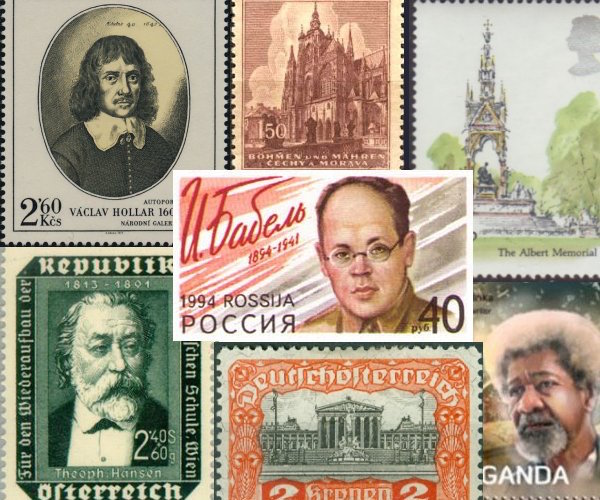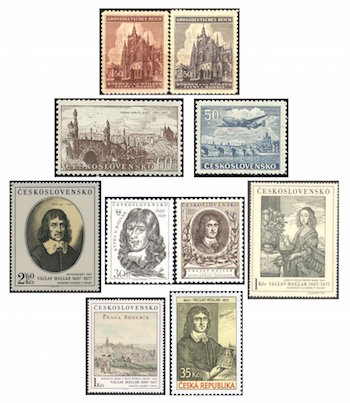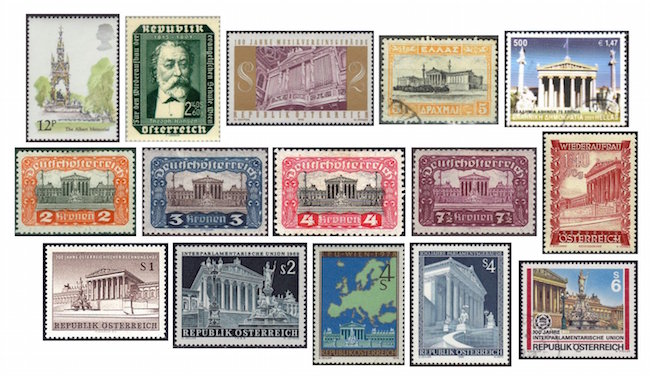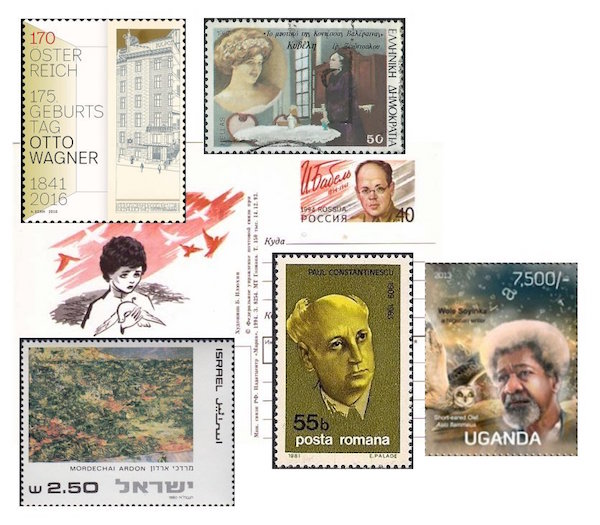The Arts on Stamps of the World — July 13
An Arts Fuse regular feature: the arts on stamps of the world.

By Doug Briscoe
July 13 seems to be Architects Day, as we have no fewer than four of them to salute, along with Isaac Babel, Capt. Jean-Luc Picard, Han Solo, and the inventor of the Rubik’s Cube.
On this day 618 years ago the German-Bohemian architect Peter Parler died. Born in 1333, he came from a family of master builders and was active in Strasbourg, Cologne, and Nuremberg before settling in Prague from the age of 23. It was in that city that he left his mark. After the death of French architect Matthias of Arras in 1352, HRE Charles IV named Parler to take charge of the building of St. Vitus Cathedral (see the stamps). He also created the Charles Bridge over the Vlatava (Moldau) River, which was completed in 1402, three years after Parler’s death on 13 July 1399. Parler was also the principal designer of the New Town in the center of Prague and left many other structures, sculptures, and tombs in the area. The stamps showing the cathedral were issued under the Nazi administration of the country, thus “Grossdeutsches Reich” at the top of the issues, while the stamps for the bridge date from the postwar period.
Another artist who worked in Prague—indeed, was born there, albeit two centuries later—was the Czech etcher Václav Hollar (13 July 1607 – 25 March 1677). Czechoslovakia has done this native son proud with a good half dozen stamps over the years. Apprenticed to an engraver, Hollar wound up in Cologne, where he was “discovered” by the Earl of Arundel and traveled with him to Vienna and back to Prague before the Earl returned home to England with Hollar—now “Wenceslaus” Hollar—in tow. During the English Civil War he fought on the side of the Royalists (natch) and spent some time in Antwerp. He returned to London in 1652, died there, and was buried at St Margaret’s Church, Westminster, leaving 3,000 etchings and a further 400 drawings.

The prolific builder Sir Gilbert Scott (13 July 1811 – 27 March 1878) is the creator of London’s Albert Memorial, completed in 1876 (see the stamp). Scott left a great many public and private buildings, and designed or renovated a large number of churches and cathedrals, mostly in the Gothic revival. In addition to his 800+ structures in Britain, he built the Nikolaikirche in Hamburg, Germany (1845–80). This was bombed in World War II, damaged so severely that all but the tower was demolished in 1951. Some of Scott’s other most notable projects were the Midland Grand Hotel at St Pancras station (1865), the Foreign and Commonwealth Office (1861-68), and St Mary’s Cathedrals in Edinburgh and Glasgow. Scott also had many pupils.
Architect No. 3 is the Danish-born Theophil von Hansen (13 July 1813 – 17 February 1891), whose most celebrated work is perhaps Vienna’s Musikverein concert hall (1867-70). (The Austrian stamp gives us no glimpse of the facade, however, rather the organ in the hall.) But to back up a bit, Hansen moved from Denmark to Athens in 1837 and did a good deal of work there, including the Academy of Athens, seen on two stamps, one old (1927), one new (2001). The National Observatory of Athens also came from his hand before the architect moved on to Vienna in 1846. There he built a number of grand buildings on Vienna’s Ring, most prominently the Parliament building, which shows up on a fair number of Austrian stamps from as early as 1919 (I just had to show a few of these, I think they’re so darn pretty). Later versions, arranged here in chronological sequence, came in 1948, 1961, 1969 (dark blue, with the Pallas Athena Fountain—part of Hansen’s plan—prominent; my favorite of the more recent ones), 1978, 1983, and 1989. One of Hansen’s other Viennese structures is the Holy Trinity Greek Orthodox Church (1858-61). He returned to Greece for the Zappeion (1874-78) and the National Library of Greece, but died back in Vienna, aged 77.

One of the architects with whom Hansen worked was Otto Wagner (13 July 1841 – 11 April 1918), who was born in Vienna, but who, as the product of a later generation, left his mark in a more modernist style, for example, in the Church of St. Leopold (1903-07), his home outside the city, the Wagner Villa, and the Karlsplatz rail station. (Wagner was also an urban planner who was responsible for the design of the Wiener Stadtbahn, the metropolitan railway system.) I find none of Wagner’s structures highlighted on stamps, but he himself was honored with one just last year that shows a bit of the facade of his Postal Office Savings Bank (1894–1902).

Today is also the birthday of the Greek actress who went by the name Cybele (Κυβέλη). She was born illegitimate in 1888 and was adopted from an orphanage by a family named Andrianou. She went on the stage in her mid teens and came to be associated with the plays of Tolstoy, Goldoni, and Ibsen rather than with the Greek tragedians. The dramatist Gregorios Xenopoulos wrote a play for her every year from 1908 to 1925. She acted in only two films and one ancient Greek comedy, Lysistrata. Cybele died, aged 89, on 26 May 1978.
Although there is as of yet no stamp for the wonderful writer Isaac Babel (13 July [O.S. 1 July] 1894 – 27 January 1940), Russia did issue a postal card for him in 1994. An admirer of Maupassant and Flaubert, young Babel wrote his first stories in French, though none of this work is extant. He met Gorky, who took Babel under his wing, just before the revolution. After work as a journalist, Babel was assigned to the 1st Cavalry Army (which you may recall was painted by Mitrofan Grekov). Babel’s experiences formed the basis of his story collection Red Cavalry (1926). Himself a Communist, Babel lapsed into relative silence as Stalinism gripped the country. An exception was his play Maria, which was banned in the Soviet Union until its collapse. Babel did work on some Soviet propaganda films and was permitted to travel to Paris and Berlin, but ultimately he was arrested in 1939 and judicially murdered the following year.
Born just two years after Babel in the then Austro-Hungarian Empire, Mordecai Ardon (né Max Bronstein, July 13, 1896 – June 18, 1992) emigrated to Jerusalem in 1933. Inspired by Jewish mysticism, the Kabbalah in particular, Ardon created a set of stained-glass windows, the “Ardon Windows“, for the National Library of Israel. The stamp shows his View of Jerusalem.
The works of Romanian composer Paul Constantinescu, born on this day (O.S. 30 June) in 1909, reflect his interest in both Romanian folk music and Byzantine chant. He wrote two operas, two Byzantine oratorios, two symphonies and a Sinfonietta, three concertos, string quartets, and film music. He died on 20 December 1963.

The first African to win the Nobel Prize in Literature was Akinwande Oluwole Babatunde Soyinka, Wole Soyinka for short. He is a Nigerian of the Yoruba people. With an ardent political consciousness, he opposed British control of his homeland as well as various Nigerian leaders since independence, as a result of which he has been more than once imprisoned and compelled to live in exile, though he was able to return to Nigeria in 1999. Soyinka was at first exclusively a playwright, but soon wrote some stories and a novel, The Interpreters (1964). His first poetry collection appeared in print in 1967. A second novel, Season of Anomy, followed in 1972. Soyinka has also written memoirs, essays, and screenplays. His Nobel Prize was awarded in 1986.
Two actors remembered on stamps for their portrayals of characters in science fiction are Sir Patrick Stewart (born 13 July 1940) of Star Trek and Harrison Ford (1942) of Star Wars. The Stewart stamp was just issued this year by Canada, one of a set of five illustrating five Star Trek captains. The US and UK Star Wars issues date from 1995 and 2015 respectively.
Famous for his eponymous cube, Ernő Rubik (born in Budapest, 13 July 1944) studied sculpture, architecture, and design and today is a professor of architecture and promoter of science. Rubik patented the cube in 1975, and it was licensed in the United States in 1979 and went into production in 1980. Since then 350 million units have been sold.
Today is the 65th birthday of Alla Pavlova (not to be confused with the dancer Anna Pavlova), a Russian composer of Ukrainian origin who has lived in New York since 1990. As of 2011 she has written eight symphonies. In 2012 the Republic of Guinea issued two souvenir sheets (shown at reduced scale) in honor of her 60th birthday. The one at left depicts her with Spanish composer and conductor Cristóbal Halffter. The mermaid is a reference to the first music Pavlova wrote in the US, a piano cycle for her daughter called “Impressions After Fairy-tales”, inspired by Hans Christian Andersen. The other sheet offers three stamps, the third one again pairing her with Halffter. Both composers were working on scores that were profoundly affected by the events of 9/11; thus the first stamp has Pavlova’s portrait next to the World Trade Center Towers. The middle stamp pays tribute to poet Anna Akhmatova, who was a strong influence on Pavlova in her youth.
A graduate of the University of Massachusetts with a B.A. in English, Doug Briscoe worked in Boston classical music radio, at WCRB, WGBH, and WBUR, for about 25 years, beginning in 1977. He has the curious distinction of having succeeded Robert J. Lurtsema twice, first as host of WGBH’s weekday morning classical music program in 1993, then as host of the weekend program when Robert J.’s health failed in 2000. Doug also wrote liner notes for several of the late Gunther Schuller’s GM Recordings releases as well as program notes for the Boston Classical Orchestra. For the past few years he’s been posting a Facebook “blog” of classical music on stamps of the world, which has now been expanded to encompass all the arts for The Arts Fuse.
